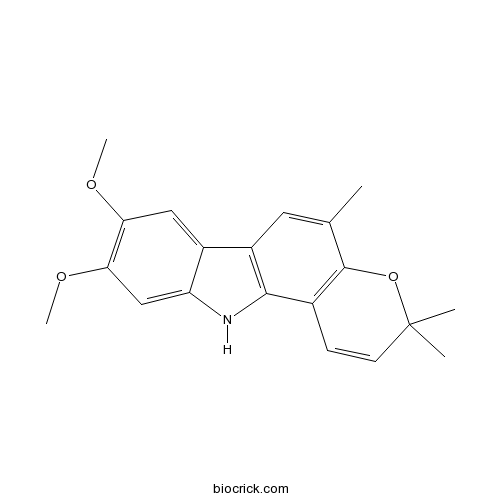KoenigicineCAS# 24123-92-0 |

Quality Control & MSDS
3D structure
Package In Stock
Number of papers citing our products

| Cas No. | 24123-92-0 | SDF | Download SDF |
| PubChem ID | 278055 | Appearance | Yellow powder |
| Formula | C20H21NO3 | M.Wt | 323.4 |
| Type of Compound | Alkaloids | Storage | Desiccate at -20°C |
| Synonyms | Kenidine; Kenigicine; Kenimbidine; Koenidine; Koenimbidine | ||
| Solubility | Soluble in methanol; slightly soluble in water | ||
| Chemical Name | 8,9-dimethoxy-3,3,5-trimethyl-11H-pyrano[3,2-a]carbazole | ||
| SMILES | CC1=CC2=C(C3=C1OC(C=C3)(C)C)NC4=CC(=C(C=C42)OC)OC | ||
| Standard InChIKey | IUZVYLWUISSZCS-UHFFFAOYSA-N | ||
| Standard InChI | InChI=1S/C20H21NO3/c1-11-8-14-13-9-16(22-4)17(23-5)10-15(13)21-18(14)12-6-7-20(2,3)24-19(11)12/h6-10,21H,1-5H3 | ||
| General tips | For obtaining a higher solubility , please warm the tube at 37 ℃ and shake it in the ultrasonic bath for a while.Stock solution can be stored below -20℃ for several months. We recommend that you prepare and use the solution on the same day. However, if the test schedule requires, the stock solutions can be prepared in advance, and the stock solution must be sealed and stored below -20℃. In general, the stock solution can be kept for several months. Before use, we recommend that you leave the vial at room temperature for at least an hour before opening it. |
||
| About Packaging | 1. The packaging of the product may be reversed during transportation, cause the high purity compounds to adhere to the neck or cap of the vial.Take the vail out of its packaging and shake gently until the compounds fall to the bottom of the vial. 2. For liquid products, please centrifuge at 500xg to gather the liquid to the bottom of the vial. 3. Try to avoid loss or contamination during the experiment. |
||
| Shipping Condition | Packaging according to customer requirements(5mg, 10mg, 20mg and more). Ship via FedEx, DHL, UPS, EMS or other couriers with RT, or blue ice upon request. | ||

Koenigicine Dilution Calculator

Koenigicine Molarity Calculator
| 1 mg | 5 mg | 10 mg | 20 mg | 25 mg | |
| 1 mM | 3.0921 mL | 15.4607 mL | 30.9215 mL | 61.8429 mL | 77.3036 mL |
| 5 mM | 0.6184 mL | 3.0921 mL | 6.1843 mL | 12.3686 mL | 15.4607 mL |
| 10 mM | 0.3092 mL | 1.5461 mL | 3.0921 mL | 6.1843 mL | 7.7304 mL |
| 50 mM | 0.0618 mL | 0.3092 mL | 0.6184 mL | 1.2369 mL | 1.5461 mL |
| 100 mM | 0.0309 mL | 0.1546 mL | 0.3092 mL | 0.6184 mL | 0.773 mL |
| * Note: If you are in the process of experiment, it's necessary to make the dilution ratios of the samples. The dilution data above is only for reference. Normally, it's can get a better solubility within lower of Concentrations. | |||||

Calcutta University

University of Minnesota

University of Maryland School of Medicine

University of Illinois at Chicago

The Ohio State University

University of Zurich

Harvard University

Colorado State University

Auburn University

Yale University

Worcester Polytechnic Institute

Washington State University

Stanford University

University of Leipzig

Universidade da Beira Interior

The Institute of Cancer Research

Heidelberg University

University of Amsterdam

University of Auckland

TsingHua University

The University of Michigan

Miami University

DRURY University

Jilin University

Fudan University

Wuhan University

Sun Yat-sen University

Universite de Paris

Deemed University

Auckland University

The University of Tokyo

Korea University
- Platachromone B
Catalog No.:BCN9520
CAS No.:1606149-63-6
- Isophrymarol acetate
Catalog No.:BCN9519
CAS No.:115196-17-3
- Pityrogrammin
Catalog No.:BCN9518
CAS No.:55601-60-0
- Rhodomyrtosone I
Catalog No.:BCN9517
CAS No.:1402725-98-7
- Buxifoliadine A
Catalog No.:BCN9516
CAS No.:263007-65-4
- 1,3-Dihydroxy-2,4-diprenylacridone
Catalog No.:BCN9515
CAS No.:1205687-48-4
- Teuvincenone B
Catalog No.:BCN9514
CAS No.:127419-64-1
- 2-Demethoxyleptostachyol acetate
Catalog No.:BCN9513
CAS No.:139405-55-3
- 3,5,6,7,8,3'-Hexamethoxy-4',5'-methylenedioxyflavone
Catalog No.:BCN9512
CAS No.:82668-99-3
- Trigothysoid L
Catalog No.:BCN9511
CAS No.:1501943-06-1
- 2,4,6-Trihydroxyisovalerophenone
Catalog No.:BCN9510
CAS No.:26103-97-9
- Isoengeletin
Catalog No.:BCN9509
CAS No.:30987-58-7
- Dihydrokaempferol 3-O-glucoside
Catalog No.:BCN9522
CAS No.:31049-08-8
- 5'-Demethoxycyrtonesin A
Catalog No.:BCN9523
CAS No.:1179524-22-1
- 6-Demethoxyleptostachyol acetate
Catalog No.:BCN9524
CAS No.:126298-48-4
- 22-Hydroxycyclolaudenol
Catalog No.:BCN9525
CAS No.:2077090-18-5
- Buxifoliadine B
Catalog No.:BCN9526
CAS No.:263007-66-5
- 4'-O-Methylatalantoflavone
Catalog No.:BCN9527
CAS No.:1205687-49-5
- Severibuxine
Catalog No.:BCN9528
CAS No.:219998-24-0
- 3,5,8,3'-Tetramethoxy-6,7,4',5'-bis(methylenedioxy)flavone
Catalog No.:BCN9529
CAS No.:82668-93-7
- Bletillatin A
Catalog No.:BCN9530
CAS No.:2387570-11-6
- Trigothysoid O
Catalog No.:BCN9531
CAS No.:1501943-09-4
- Koenigine
Catalog No.:BCN9532
CAS No.:28513-33-9
- Murrastinine C
Catalog No.:BCN9533
CAS No.:20105-20-8
Versatile oxidative approach to carbazoles and related compounds using MoCl5.[Pubmed:24354638]
Org Lett. 2014 Jan 17;16(2):402-5.
The unique oxidizing power of molybdenum pentachloride provides an easy to perform, versatile, and high yielding method to construct carbazoles and the corresponding dibenzo analogues of thiophene, furan, and selenophene. The coupling reaction tolerates a variety of functional groups. The synthesis is highly modular. By this approach a precursor for the naturally occurring carbazole Koenigicine was prepared.
Pancreatic lipase inhibitory alkaloids of Murraya koenigii leaves.[Pubmed:19768989]
Nat Prod Commun. 2009 Aug;4(8):1089-92.
In the continuing search for newer pancreatic lipase inhibitors from plants, a total of 63 extracts from 21 different plants were screened to study their pancreatic lipase (PL) inhibitory activity in vitro. All three extracts (DCM, EtOAc and MeOH) of Murraya koenigii (L.) Spreng leaves (Rutaceae) exhibited antilipase activity greater than 80%. Further, bioactivity guided fractionation of the EtOAc extract led to the isolation of four alkaloids, namely mahanimbin, koenimbin, Koenigicine and clausazoline-K, with IC50 values of 17.9 microM, 168.6 microM, 428.6 microM and <500 microM, respectively. This study reports for the first time the PL inhibitory potential of carbazole alkaloids from plants.


